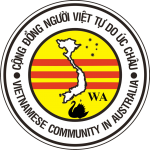the Freedom and Heritage Flag of Vietnam
The flag of the Vietnamese Community in Australia / WA shall be the Yellow Flag with Three Red Stripes as a formal symbol to be used during activities and rituals of the Association. The flag symbolises Freedom, Democracy and Human Rights which is considered as idealism for Vietnamese who are communist refugees.
==============================================================
The Freedom and Heritage Flag of Vietnam
The flag of former South Vietnam was designed by Emperor Thành Thái in 1890 and was used by Emperor Bảo Đại in 1948. It was the flag of the former State of Vietnam (the French-controlled areas in both Northern and Southern Vietnam) from 1949 to 1955 and later of the Republic of Vietnam (South Vietnam) from 1955 until April 30, 1975 when the south unconditionally surrendered to the north, where it was officially joined in a unified Vietnam a year later. The flag consists of a yellow field and three horizontal red stripes to and can be explained as either symbolising the unifying blood running through northern, central, and southern Vietnam, or as representing the symbol for “south” (as in, south from China), in Daoist trigrams. It is still used by some Vietnamese immigrants now living in other countries. From February 2003 to January 2006, in the United States, nine states, three counties and 76 cities have adopted resolutions recognizing the yellow flag as the “Vietnamese Heritage & Freedom Flag“
Origins
| In 1802-1820, Emperor Gia Long, the yellow flag was also used as the symbol of the Empire of Vietnam. In 1890, the Emperor Thành Thái passed a decree, changing the flag with Chinese characters to a new flag. The yellow flag with three red stripes was created and used for the first time as the national flag (Đại Nam National Flag 1890-1920). It should be noted that the yellow flag with three red stripes (called The Yellow Flag for short) is the first true “national flag” of the Vietnamese people for it reflects the aspiration and hope of the people, not just the emperors, for independence and unification of the Viet nation.
In 1916-1925, after Emperors Thanh Thai and Duy Tan were exiled to Africa and obeying the French, Emperor Khải Định issued a decree to change the national flag, the Yellow Flag, which signified the three unified regions (North, Central, and South) was replaced by a yellow flag with one red horizontal stripe. This yellow flag with one red stripe was also called the “Long Tinh” flag because it was transformed from the original Long Tinh flag of the Nguyen Dynasty. In 1945, during Tran Trong Kim’s government that is called the Empire of Vietnam by Japan, the two red bands were added to the middle broken red band to form the Quẻ Ly Flag. The Quẻ Ly Flag was the official flag of Vietnam at that time. Quẻ Ly is a divination trigram of “fabulous unicorn”, sixth of the Bát Quái (the Eight Trigrams): Càn, Khâm, Cấn, Chấn, Tốn, Ly, Khôn, Đoài. This divination sign of fabulous unicorn represents the sun, fire, beam of light, and civilization. And more importantly, it also represents the direction of south, emphasizing that Vietnam, as the lands “passed the clouds” (see Yunnan) is southward from China.(See I Ching). In 1948, when the former Emperor Bảo Đại became the Chief of State of Vietnam, he ordered to change the broken red band (which was then the central element of the Vietnamese flag) into a continuous red band, and form the Yellow Flag with three yellow red bands. On 2 June, 1948, the Chief of the Provisional Central Government of Vietnam, Brigadier General Nguyen Van Xuan, signed an ordinance to specify the characteristics of the Vietnamese National Flag as follows: “The national emblem is a flag of yellow background, the height of which is equal to two-thirds of its width. In the middle of the flag and along its entire width, there are three horizontal red bands. Each band has a height equal to one-fifteenth of the width. These three red bands are separated from one another by a space of the band’s height.”The three red bands have the divination sign of Quẻ Càn, the first of the Eight Trigrams mentioned above. Quẻ Càn represents heaven. Based on the worldview of Vietnamese people, Quẻ Càn indicates the South Sky, the Vietnamese Nation, Vietnamese people, and the people’s power. Another interpretation places the three red bands as symbols of the three regions of Vietnam: North, Central, and South. The yellow or gold background on the flag represents the Vietnamese skin color. The flag was used by the Republic of Vietnam (more commonly known as South Vietnam) for the duration of that state’s existence (1954 – 1975). It was abolished by Vietnamese government on April 30, 1975. |
The National Flag of Viet Nam: Its Origin and Legitimacy





